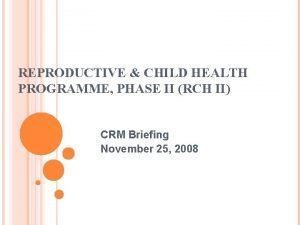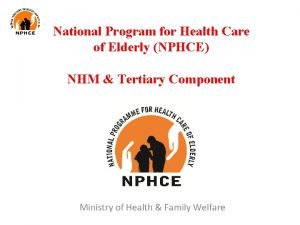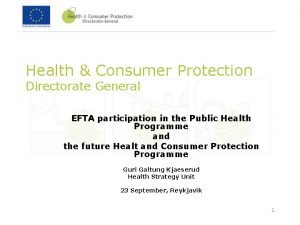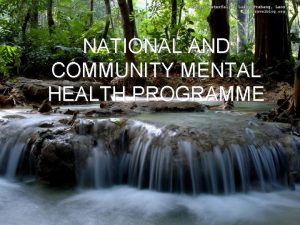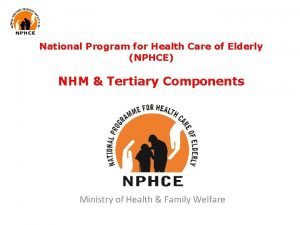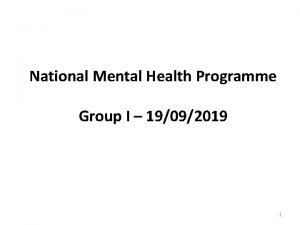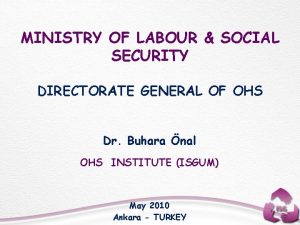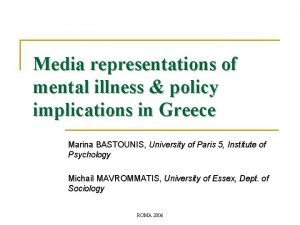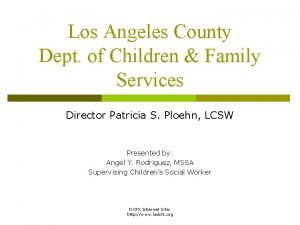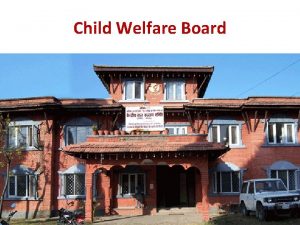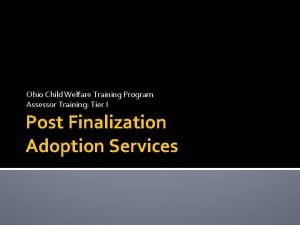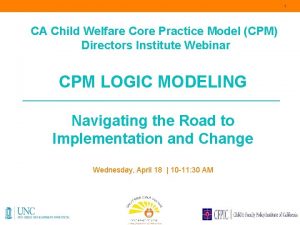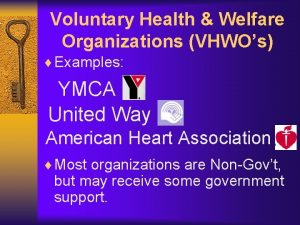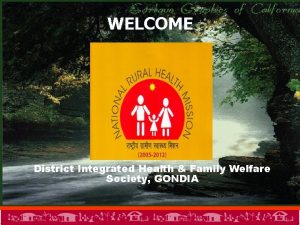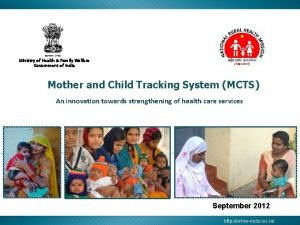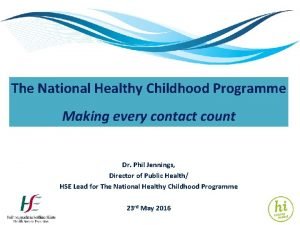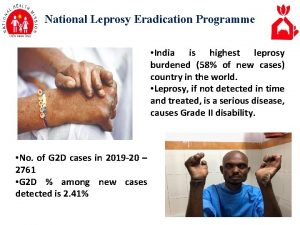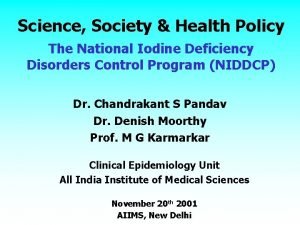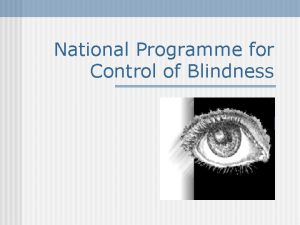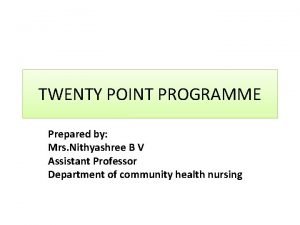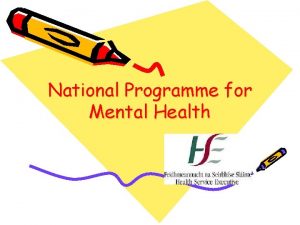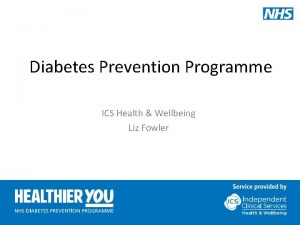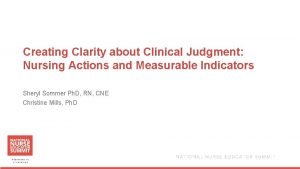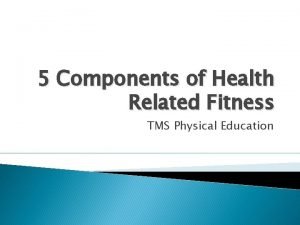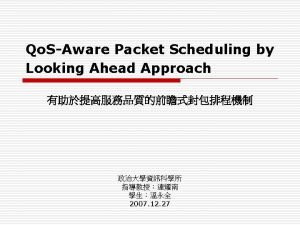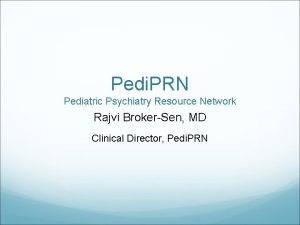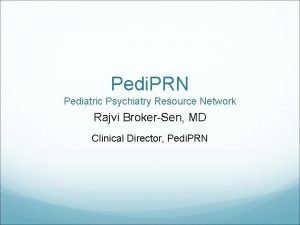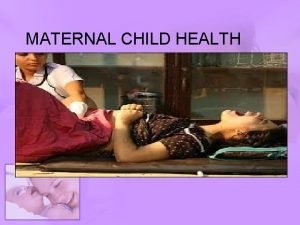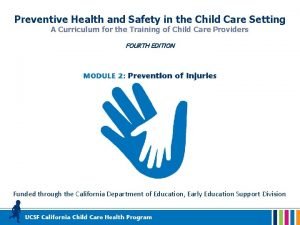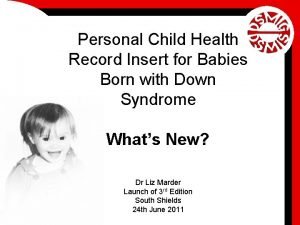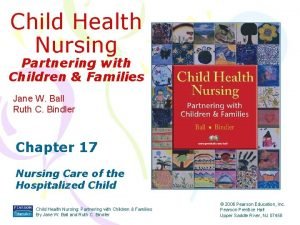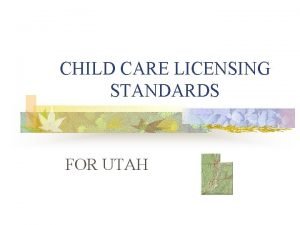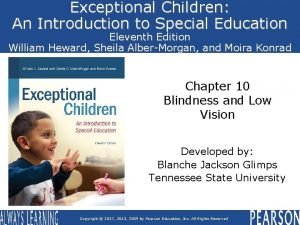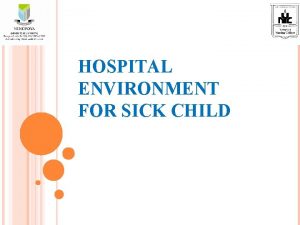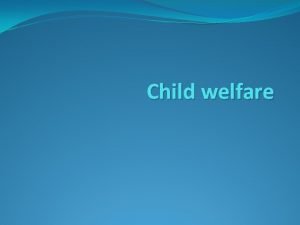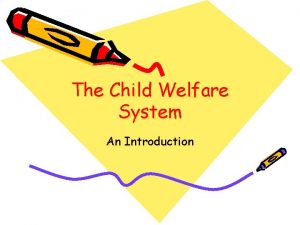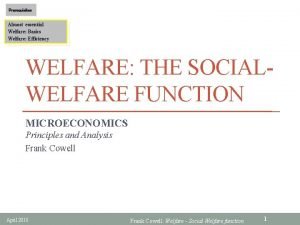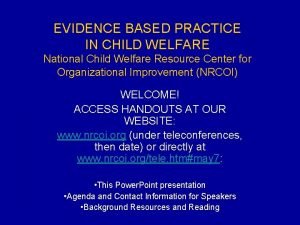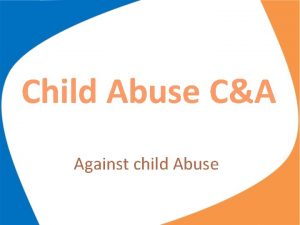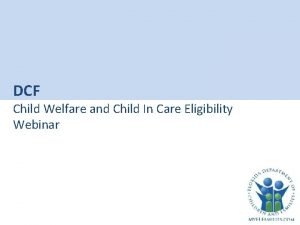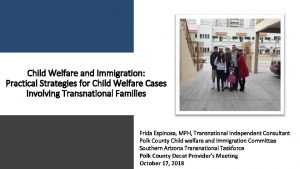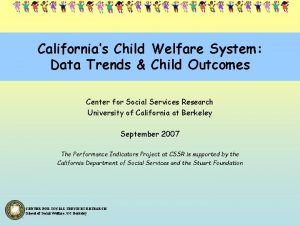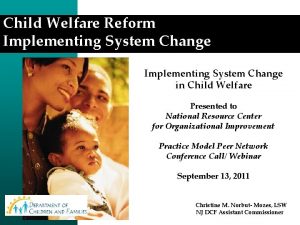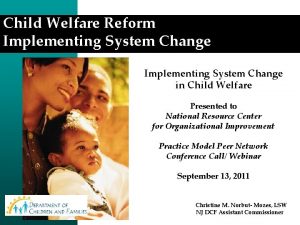NATIONAL HEALTH PROGRAMME RELATED TO CHILD WELFARE INTRODUCTION









































































- Slides: 73

NATIONAL HEALTH PROGRAMME RELATED TO CHILD WELFARE

INTRODUCTION: The ministry of health, Government of India, central health council launch programs aimed at controlling or eradicating diseases which cause considerable morbidity and mortality in India.

HEALTH PROGRAMME 1. 2. NATIONAL RURAL HEALTH MISSION NATIONAL PROGRAMS RELATED TO MOTHER AND CHILD CARE 1. 2. 3. 4. 5. Maternal and child health program (MCH) Integrated child development service scheme (ICDS) Child survival and safe motherhood program(CSSM) Reproductive and child health program(RCH) Integrated management of neonatal and childhood illness

NATIONAL PROGRAMS RELATED TO COMMUNICABLE DISEASES National program of immunization Acute respiratory infection control program Diarrheal disease control program Revised national tuberculosis control program Leprosy eradication program National vector borne disease control programs National malaria eradication program National Filarial control program KALA AZAR control program National AIDS control program

NATIONAL PROGRAMS RELATED TO CONTROL OF NUTRITIONAL DEFICIENCY DISORDERS 1. 2. 3. 4. Special Nutritional program 1970 Mid-day meal program. 1957 Anemia prophylaxis program. 1970 National iodine deficiency disorders control program. 1962

NATIONAL PROGRAMS RELATED TO CONTROL OF NON COMMUNICABLE DISEASE National School health program National mental health program National program for control of blindness Vitamin A deficiency control program National cancer control program National diabetes control program Child welfare program for disabled children National water supply and sanitation program National family welfare program Minimum needs program

NATIONAL RURAL HEALTH MISSION 12 APRIL, 2005

GOALS Reduction in IMR and MMR Universal access to public health services Prevention and control of communicable and non communicable diseases. Access to integrated comprehensive primary health care.

Population stabilization, gender and demographic balance. Revitalize local health traditions and mainstream AYUSH Promotion of healthy life styles

STRATEGIES enhance capacity of panchayti raj institutions to own, control and manage public health services. Promote access to improve health care at house hold level through the ASHA Health plan for each village through village health committee of the panchayat Strengthening sub-centre through an untied fund to enable local planning and action and more multi-purpose workers.

Prepared by the district health Mission, including drinking water, sanitation and hygiene and nutrition. Technical support to National, State Block and district levels traditions. Reorienting medical education to support rural health issues including regulation of medical care and medical ethics. Mainstreaming AYUSH revitalization local health.

NATIONAL PROGRAMS RELATED TO MOTHER AND CHILD CARE

MATERNAL AND CHILD HEALTH PROGRAME OBJECTIVES OF MCH: To reduce maternal, infant and childhood mortality and morbidity. To promote reproductive health To promote physical and psychological development of children and adolescent within the family.

SERVICES Servics delivered by multipurpose health workers Record of occurrence of pregnancy identify women with anemia Administered 2 doses Tetanus Toxoid. Provide iron and folic acid tablet to pregnant women

Screen women identified as pregnant for any of the risk factor Age less than 17 years or over 35 years historyof cesarean section height <145 cm Risk factor history still births history of bleeding in previous pregnancy Weight <40 kg or >70 kg.

CARE OF CHILDREN Monitoring of growth of children to detect malnutrition. Immunization Treatment of common ailments Referral cases to higher centers Implementation national health policies.

INTEGRATED CHILD DEVELOPMENT SERVICE SCHEME (ICDS) (1975) TARGET: holistic development of children OBJECTIVE To improve the nutritional and health status of children in the age group 0 -6 years. To reduce mortality, morbidity, malnutrition and school dropout. To lay the foundation for proper psychological, physical and social development of the child.

To achieve effective co-ordination of policy and implementation amongst the various departments to promote child development To enhance the capability of the mother to look after the normal health and nutritional needs of the child through proper nutrition and health education.

BENEFICIARY Children of below 3 years age group SERVICES Health checkup Immunization Referral services Supplementary nutrition Children of 3 -6 year age group Non formal preschool education Health checkup Immunization Referral services Supplementary nutrition Expectant and nursing women Health check up Immunization against tetanus of expectant Nutrition and health education Supplementary nutrition Other women of 15 to 45 years Nutritional and health education

CHILD SURVIVAL AND SAFE MOTHERHOOD PROGRAM (1992) AIMS To reduce infant mortality. Provide antenatal care to all pregnant women. Ensure safe delivery services. Provides basic care to all neonates. Identify and refer these neonates, who are at risk.

REPRODUCTIVE & CHILD HEALTH(RCH) Family welfare CSSM 1997 RCH

OBJECTIVES The program integrates all interventions of fertility regulation, maternal and child health with reproductive health for both men and women. The service to be provided are client oriented, demand driven, high quality and based on needs of community through decentralized participatory planning and target free approach.

The program up gradation of the level of facilities for providing various interventions and quality of care. The first referral Units (FRUs) being set-up at sub district level provide comprehensive emergency obstetric and new born care. Facilities of obstetric care, MTP and IUD insertion in the PHCs level are improved. Specialist facilities for STD and RTI are available in all district hospitals and in a fair number of subdistrict level hospitals.

COMPONENTS community participation safe familly mothrhood welfre and planning child survival prevention of RTI/STD adolscvence client participation

SERVICES PROVIDED For the children Essential newborn care Exclusive breastfeeding Immunization Appropriate management of ARI Vitamin A prophylaxis Treatment of anemia

For the mother Tetanus Toxoid immunization Prevention and treatment of anemia Antenatal care and early identification of maternal complications. Delivery by trained personnel Promotion of institutional deliveries Management of obstetrical emergencies Birth spacing

For the Eligible couple Prevention of pregnancy Safe abortion For RTI/STD Prevention and treatment of reproductive tract infection and sexually transmitted diseases. RCH program is a target-free program with voluntary participation.

RCH PHASE – II 1 ST APRIL, 2005 STRATEGIES Essential obstetric care Institutional delivery Skilled attendance at delivery Emergency obstetric care Operational delivery Operational PHCs and CHCs for round the clock delivery services. Strengthening referral system

"The Integrated Management of Childhood Illness (IMCI)" 1992 UNICEF and WHO

Components: Improvement of the case management skills of health providers Improvement in the overall health system. Improvement in family and community health care practices. Collaboration/coordination with other Departments

IMNCI BENEFICIARIES Care of Newborns and Young Infants (infants under 2 months) Care of Infants (2 months to 5 years)

NATIONAL PROGRAMS RELATED TO CONTROL OF COMMUNICABLE DISEASE

National program of immunization. 1985 Acute respiratory infection control program Diarrheal disease control program (1971) Revised national tuberculosis control program 1962 Leprosy eradication program 1955 National vector borne disease control programs

NATIONAL PROGRAM ON IMMUNIZATION 1974 -WHO launched “Expended Programme Of Immunization” (EPI) 1978 -Govt. of India launched the same EPI programme in India 1985 –EPI renamed as Universal immunization programme

OBJECTIVES To increase immunization coverage. To improve the quality of service. To achieve self sufficiency in vaccine production. To train health personnel. To supply cold chain equipment and establish a good surviveillance network. To ensure district wise monitoring

REVISED IMMUNIZATION SCHEDULE Age Vaccines Pregnant Women TT (2 doses/Booster) Birth 6 - 8 weeks 10 -12 weeks 14 -16 weeks 7 -9 months 15 -18 months BCG, OPV-O, Hep B 1 DPT -1, OPV -1, Hep B 2, Hib 1 DPT -2, OPV -2, Hib 2 DPT -3, OPV-3, Hep B, Hib 3 Measles DPT booster, OPV – Booster, Hib, MMR 2 years 4 -5 years 5 -10 years 15 year Typhoid DTP, OPV TT, MMR 2, Hep B TT

ACUTE RESPIRATORY INFECTIONS CONTROL PROGRAM 1990 - Programme launched 1992 - the Programme was implemented as part of CSSM The WHO protocol puts two signs as the “entry criteria” for a possible diagnosis of pneumonia. cough difficult breathing. Patient treated with antibiotics ampicillin 25 -50 mg/kg/day for a period of 7 to 10 days gentamicin 5. 0 mg/kg/day.

REVISED NATIONAL TUBERCULOSIS CONTROL PROGRAMME (RNTCP) 1962 Goal The goal of TB Control Program is to decrease mortality and morbidity due to TB and cut transmission of infection until TB ceases to be a major public health problem in India.

OBJECTIVES: To achieve at least 85 % cure rate of the newly diagnosed sputum smear-positive TB patients To detect at least 70% of new sputum smearpositive patients after the first goal is met.

DRUG DOSE Drug • Isoniazid • Rifampicin • Pyrazinamide • Ethambutol • Streptomycin Dose adults 600 Mg/kg 450*Mg/kg 1500 Mg/kg 1200 Mg/kg 750 Mg/kg children 10 – 15 Mg/kg 10 Mg/kg 35 Mg/kg 30 Mg/kg 15 Mg/kg

CATEGORIES OF TB CASES AND THEIR TREATMENT REGIMENS Category II Category HI Characteristic of a TB Treatment regimen case Intensive phase Continuation phase New sputum smear 2 ( HRZE )3 4 ( HR )3 positive Seriously ill, 54 does sputum smear-negative 24 does • Seriously ill, extrapulmonary Relapse Failure Treatment after default Others 2(SHRZE)3 +1( HRZE )3 36 does 5 ( HRE )3 Sputum smear-negative Not seriously ill, extrapulmonary 2 ( HRZ )3 4 ( HR ) 3 24 does 54 does 66 does

CONTROL OF DIARRHEAL DISEASE (CDD) PROGRAM (1971) STRATEGY : To train medical and other health personnel in standard case management of diarrhea. Promote standard case management practices amongst private practitioners. Instruct mother in home management of diarrhea and recognition sign which signal immediate care. Make available the ORS (oral rehydration salts) packets free of cost

TREATMENT The rational treatment of diarrhea consists in prevention of dehydration in a by oral rehydration therapy(ORS) Breastfeeding should be continued. In dysentery given cotrimoxazole in addition to ORS. If unsatisfactory response, nalidixic acid is given for five days. Any program for diarrheal disease control must include provision of portable water.

Parent must be educated regarding storage of water and food in clear utensils, continue of breastfeeding, using of only freshly prepared weaning foods washing of hands with soap before handling food.

NATIONAL LEPROSY CONTROL PROGRAM 1955 -national leprosy control program 1955 1983 –national leprosy eradication program SERVICES Provide domiciliary treatment (MDT) Provide services through mobile leprosy treatment units with the help of PHCstaff. Organize health education deformity and ulcer care and medical rehabilitation services.

NATIONAL AIDS CONTROL PROGRAM (1987) 1987 -NACP 1991 –NACP PHASE 1 1992 -National AIDS control organization 1999 –NACP PHASE 2 2011 –NACP PHASE 3

Objective Prevent infections care, support and treatment. Strengthen- infrastructure, systems and human resources Strengthen the Strategic Information Management System

STRATEGY Surveillance of HIV infection as indicated by serum positivity. Surveillance of aids cases showing clinical signs & symptoms. Disease control strategies are targeted at three main modes of spread Sexual activity. Self injection by drug addicts HIV infected blood transfusion

Training programs for paramedical & general practitioners to enhance their capability of effective STD diagnosis. Counseling for HIV & AIDS patients Cheap availability of good quality condoms. Licensing of blood banks, encouraging voluntary blood donation & screening of blood for HIV, malaria, hepatitis B & C to be mandatory for all.

NATIONAL VECTOR BORNE DISEASE CONTROL PROGRAM

2003 - (NVBDCP) is an umbrella programme for prevention and control of Vector borne diseases. 1. Malaria 2. Dengue 3. Chikungunya 4. Japanese Encephalitis 5. Kala-Azar 6. Filaria (Lymphatic Filariasis)

NATIONAL PROGRAMS RELATED TO CONTROL OF NUTRITIONAL DEFICIENCY DISORDERS

Special nutritional program 1970 Mid-day meal program. 1957 Anemia prophylaxis program. 1970 National iodine deficiency disorders control program

SPECIAL NUTRITION PROGRAM 1970

OBJECTIVE To improve the nutritional status of preschool children, pregnant, and lactating mother of poor socio economic groups in urban slums, tribal area and drought prone rural area Child up to one 200 kcl and year child 1 -6 years. 300 kcal women 500 kcal 8 -10 g protein/day 10 -12 g proteins/day 25 g protein/day

MIDDAY MEAL PROGRAM (1961)

OBJECTIVES To raise the nutritional status of primary school children To improve attendance and enrolment in school. To prevent dropouts from primary school. Children belonging to backward classes, schedule caste, and scheduled tribe families are given priority.

PRINCIPLES: Should be a substitute. 1/3 Total energy and ½ total protein Provided at the low cost It is easily prepared Locally available food Change menu frequently.

BENEFICIARY School children in the age group 611 year SERVICES provides 300 calories and 8 -12 g protein/day for 200 days in year

Prophylaxis against Nutritional Anemia (1970) BENEFICIARY Pregnant women, Nursing mothers, Women acceptors to terminal methods and IUD. children 5 years Daily dose of iron and folic acid tablets women: 80 mg ferrous sulfate+0. 5 mg folic acid. Children: 180 mg ferrous sulfate+0. 1 mg folic acid. (2 ml liquid )

NATIONAL IODINE DEFICIENCY DISORDERS CONTROL PROGRAM (1962) 1962: NGCP launched 1984 : The central council of health approved the Policy of Universal salt Iodization (USI): Private sector to produce iodized salt 1992: NGCP renamed as NIDDCP 1997: sale and storage of common salt banned

OBJECTIVES: Surveys to assess the magnitude of the IDD. Supply of iodated salt in place of common salt Resurvey after every 5 years to assess the extent of iodine deficiency disorders and the Impact of iodated salt. Laboratory monitoring of iodated slat and urinary iodine excretion. Health education & publicity.


1. 2. 3. 4. 5. 6. 7. 8. 9. National school health program. 1977 National mental health program 1982 National program for control of blindness 1963 National cancer control program 1975 -1976 National diabetes control program Child welfare program for disabled children National water supply and sanitation program 1954 National family welfare program 1952 Minimum needs program 1974 -1978 (5 th five year plan)

SCHOOL HEALTH PROGRAMME 1977

AIMS AND OBJECTIVES Promotion of positive health Prevention of disease Timely diagnosis, treatment and follow up Health education to Inculcate awareness about good and bad health. Availability of healthful environment

COMPONENT Health appraisal Remedial measures and follow up Prevention of communicable disease Healthful environment Nutritional services First aid facilities Mental health Dental health Eye health Ear health Health education Education of handicapped children School health record

NATIONAL MENTAL HEALTH PROGRAM (1982) components 1. Treatment of Mentally ill 2. 3. Rehabilitation Prevention and promotion of positive mental health.

OBJECTIVES Provision of mental health services at district level. Improvements of facilities in mental hospitals. Training of trainers of PHC personnel in mental hospital Program for substance use disorder.

VITAMIN A DEFICIENCY CONTROL PROGRAM (1970) BENIFICERY : - 6 month -5 year children STREATGY Administration of vit A dose at a regular 6 month interval VIT A ADMINISTRATION SCHEDUALE � 6 -11 month: -100000 IU � 1 -5 year: -200000 IU /6 months �Child must receive total 9 does

PREVENT VIT-A DEFICIENCY THROUGH Promotion of breastfeeding and feeding of colostrums. Encourage the intake of green leafy vegetable and yellow colored fruit. Increase the coverage of with measles (depletes vitamin A stores)

CHILD WELFARE PROGRAM FOR DISABLED CHILDREN DISABILITY IN FIVE YEAR PLANS 1 FYP -Launched a small unit by the ministry of education for the visually impaired in 1947. 2 FYP- under ministry of education a National Advisory Council for the physically challenged started. 3 FYP-attention was given to rural areas and facilitated training and rehabilitation of the physically challenged. Cont……

4 FYP-more emphasis was given to preventive work. 6 FYP-national policies were made around for provision of community oriented disability prevention and rehabilitation services to promote self reliance.
 National programme for child health and welfare
National programme for child health and welfare National policy and legislation related to child health
National policy and legislation related to child health Voluntary health agencies
Voluntary health agencies Child welfare agencies in india
Child welfare agencies in india Example of skill-related fitness
Example of skill-related fitness Mention any two different goals of rch programme.
Mention any two different goals of rch programme. Reproductive and child health programme phase 1
Reproductive and child health programme phase 1 Nphce launch date
Nphce launch date National health programme
National health programme National health programme
National health programme Objectives of national mental health programme
Objectives of national mental health programme Nphce
Nphce National mental health programme
National mental health programme Conclusion for safety and health
Conclusion for safety and health Conclusion of health and disease
Conclusion of health and disease Family planning objectives
Family planning objectives Children and family services los angeles
Children and family services los angeles Central child welfare board
Central child welfare board Adoption assessor training ohio
Adoption assessor training ohio Child welfare
Child welfare Vr3 child welfare foundation
Vr3 child welfare foundation Cpm implementation
Cpm implementation What are the two types of physical components
What are the two types of physical components Voluntary health and welfare organizations examples
Voluntary health and welfare organizations examples District integrated health and family welfare society
District integrated health and family welfare society Mother and child tracking system
Mother and child tracking system The national healthy childhood programme
The national healthy childhood programme Ntep organogram
Ntep organogram Nptel
Nptel National collaborative outreach programme
National collaborative outreach programme National leprosy eradication programme ppt
National leprosy eradication programme ppt National manufacturing competitiveness programme
National manufacturing competitiveness programme National iodine deficiency disorders control programme
National iodine deficiency disorders control programme Mission statement for school shaala siddhi
Mission statement for school shaala siddhi National tb control program
National tb control program Stroke sentinel national audit programme
Stroke sentinel national audit programme Left child right sibling
Left child right sibling 20 point programme slideshare
20 point programme slideshare Objectives of school health programme
Objectives of school health programme Mental health programme
Mental health programme Minus desk in community medicine
Minus desk in community medicine Askov dental health education
Askov dental health education Ics diabetes
Ics diabetes Introduction for cultural programme
Introduction for cultural programme Five components of health related fitness
Five components of health related fitness Cardiovascular endurance health related fitness
Cardiovascular endurance health related fitness Clinical judgement sample items a ati
Clinical judgement sample items a ati How to get average time in hexagon agility test
How to get average time in hexagon agility test Advantages of behaviorism
Advantages of behaviorism What is agility in mapeh
What is agility in mapeh Health related physical fitness definition
Health related physical fitness definition Health related fitness
Health related fitness Skill related
Skill related Components of health related fitness
Components of health related fitness Five components of health related fitness
Five components of health related fitness 5 components of health related fitness
5 components of health related fitness Introduction vs related work
Introduction vs related work National network of child psychiatry access programs
National network of child psychiatry access programs National network of child psychiatry access programs
National network of child psychiatry access programs National tribal child support association
National tribal child support association Telethon institute for child health research
Telethon institute for child health research Define modern concept of child care
Define modern concept of child care Modern concept of paediatric nursing
Modern concept of paediatric nursing History of maternal and child health
History of maternal and child health Definition of pediatric nurse
Definition of pediatric nurse Mch indicators full form
Mch indicators full form Preventive health and safety in the child care setting
Preventive health and safety in the child care setting Personal child health record
Personal child health record Parental rights over child's health
Parental rights over child's health Child health nursing gnm 2nd year question paper
Child health nursing gnm 2nd year question paper Utah child care licensing
Utah child care licensing Exceptional children an introduction to special education
Exceptional children an introduction to special education Sick child introduction
Sick child introduction Child labour
Child labour






